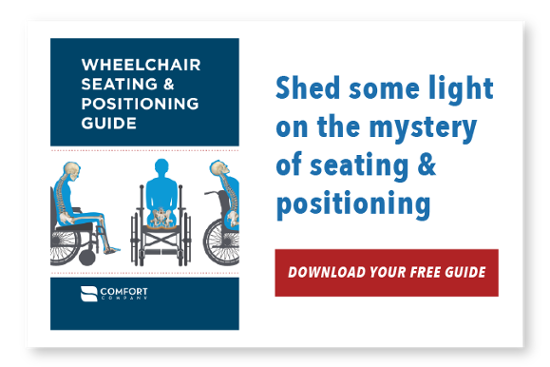Part 4 in our series A to Z Considerations for Seating & Wheeled Mobility: A Quick Reference Clarifying Confusion Around CRT. See Part 1, Part 2, Part 3, Part 4, Part 5, Part 6, Part 7, Part 8, Part 9, Part 10, Part 11, Part 12, Part 13, Part 14, Part 15, Part 16, Part 17, Part 18, and Part 19.
Last week, we wrapped up by beginning to discuss the actual wheelchair evaluation, and I am going to walk you through each step of a complete wheelchair evaluation. Yes, this evaluation can easily be incorporated into your normal documentation and you will develop a flow that becomes efficient for you.
There are some important items that need to be addressed when considering wheeled mobility for any individual, and some of these items ARE part of your typical PT/OT evaluation while others may be new. And, while new can feel scary and the unfamiliar can make us question our competency, believe me that you CAN and WILL become a successful therapist in this specialty area if you incorporate into your practice the principles I share over the next several weeks.
As Julie Andrews instructs in her famous quote from the Sound of Music, “Let’s start at the very beginning, a very good place to start.” So, we will do just that.
STEPS TO A SUCCESSFUL WHEELCHAIR EVALUATION
We are going to begin by looking at the importance of the “interview” portion of your evaluation, including taking a complete medical history, discussion of lifestyle, and asking the individual about his/her own personal goals as they relate to wheeled mobility and potential seating and positioning needs.
1. We must identify the primary as well as all potentially relevant secondary diagnoses: Which of these is the reason for the need for wheeled mobility? By identifying the diagnosis or diagnoses causing the mobility limitation, we can begin to think about what this individual may qualify for based on the insurer as well as what type of mobility equipment the individual will require to maximize his/her functional independence. Be sure to ask questions regarding the onset, prognosis, and potential progression of the condition as well as how the condition has presented in the past for that specific individual as this may impact your equipment selection. Ask, has the condition been stable, progressive or presented with exacerbations followed by remissions? Does the equipment need to be adjustable based on possible changing needs? Also, it is critical to identify whether the wheeled mobility and seating system will be needed for short-term versus long-term use.
2. When performing your complete medical history and assessment of lifestyle, be sure to gather information about the following:
- Medications: Ask about any and all potentially pertinent medications being taken related to spasticity management, pain control, cardiopulmonary conditions, bowel and bladder function, etc.
- Surgical history: Ask about past or future surgeries or medical interventions (NOTE: future surgeries may result in functional change, which could impact appropriate mobility equipment selection).
- Complete analysis of ALL body systems, past and current: Consider pulmonary conditions, cardiac issues, tone/spasticity issues, edema, bowel and bladder dysfunction, visual and/or hearing deficits, pain, skin (discuss all past or current pressure injuries, including stage 1; assess whether the client is at high risk for developing pressure injuries), etc.
- Cognition: Consider memory, impulsivity, learning deficits. Is the individual capable of safely using the equipment?
- MRADLs: What activities does this individual typically participate in or have the potential to participate in and complete independently from a seated position at home, school, work, or in the community? These may be related to bathing, dressing, toileting, eating, cooking, meal preparation, child care, financial management, home management, shopping, necessary errands such as going to the bank, medical appointments, and any religious, community, or family events. We want to maximize an active lifestyle as much as possible while keeping in mind that, under Medicare, the individual must require the equipment to function WITHIN the home.
- Home environment: Ask about the types of flooring within the home, doorway widths, size of rooms and bathroom (Is there room for a wheelchair? If you are considering a power wheelchair, this may impact the base you select, i.e. mid-wheel drive versus front-wheel drive.), stairs to enter the home as well as within the home (Are there plans for a ramp and/or chair lift?), uneven surfaces, height of counter tops, tables, beds, toilets, and the presence of a shower versus tub.
 |
 |
|
*TIP: the home MUST be accessible. This means the prescribed equipment has to not only be able to safely maneuver within the home for MRADLs, but there must also be at least one entrance that is accessible via wheelchair. |
|
- Outside environment: Assess the presence of grass, gravel, pavement, ramps, curbs, uneven surfaces, and height of work surfaces.
- Current equipment: If the individual currently has wheeled mobility equipment, what works and what doesn’t work for the client? Have there been changes in the client presentation making the current equipment no longer appropriate? Is the current equipment broken? If so, can it be repaired?
- Size and weight: Note possible changes in size and weight due to a progressive disease, a pediatric client, a new SCI who possibly lost weight initially following injury but will typically gain due to the onset of inactivity, and diagnosis. Cerebral Palsy clients tend to grow more in length and not width while Spina Bifida patients typically grow more in width and not length.
- Individual goals: If the client and family’s goals are not addressed, then the prescribed piece of equipment may end up sitting in a closet or in the garage, and this certainly does not accomplish our goals nor the individual’s goals. LISTEN to your client!
Next week’s post will begin looking at the physical assessment portion of the evaluation. I am excited to explore how this impacts our thought process when it comes to wheeled mobility and our client’s seating and positioning needs!
Resources: Cole, Elizabeth, MSPT, ATP. “Steps in the Provision of Wheeled Mobility and Seating- Part 1.” U.S. Mobility; www.VGM.com.

Lindsey Sharpe, PT, DPT
Clinical Education Manager Rehab Division

